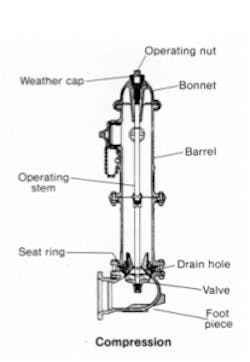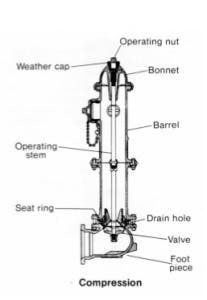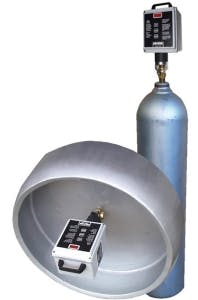The case for inspecting fire hydrants
The Imperative to Inspect
Fire hydrants exist to protect life and property from the perils of fire. Certainly, they have other uses, but their role in protecting us day in and day out is acknowledged to be their primary purpose. So, why is it that the proper repair and maintenance of something this important to every one of us can be so easily overlooked? It could be argued that by answering this question now, there would be little need to read further in this paper. True enough, but for the sake of fostering a clearer understanding of what such an inspection normally entails, let's go on.
In most cases, it's the water utility that has the responsibility for buying, installing, maintaining and repairing fire hydrants. Because the hydrant is such a key part of a community's fire protection system, it is recommended that fire hydrants be inspected twice yearly. Obviously, the local fire department shares a critical interest in the serviceability of a community's hydrants, and so it seems reasonable, especially in smaller communities, to call on the fire department for some assistance with these inspections. In addition to helping the utility, fire personnel can also view the inspection process as another opportunity to train newer fire fighters in the construction and operation of this important piece of fire fighting equipment.
Anyone conducting a fire hydrant inspection should be completely familiar with the design and operation of the various types of hydrants in the system. This includes not only fire hydrants from different manufacturers, but also what differentiates one brand's hydrants made in different years. Fortunately, both the brand and year of manufacture are usually easily determined by looking at the casting marks on each hydrant's exterior. In addition, most water utilities maintain extensive records of such information, including the styles of nozzle threads and shapes of nozzle caps and operating nuts -- all vital information for the local fire department to know. Do not hesitate to ask the hydrants' manufacturers to provide literature, manuals or parts posters to help train personnel.
Dry barrel hydrants are called this because the hydrant's main valve that controls the flow of water from the hydrant is located well below the frost line, and normally when the hydrant is idle, water is not present inside the upper part of the hydrant where it would otherwise be subject to freezing. Special valves at the base of the hydrant allow any water left inside to drain away into the ground after the hydrant is used and the main valve closed. Frozen water inside a hydrant can cause serious damage and render the hydrant unusable.
Today, most fire hydrants are of the "compression type." This means the hydrant's main valve closes with water pressure and opens against it. This design allows water pressure entering from beneath the hydrant to help the main valve seal more tightly, significantly reducing the likelihood for leakage and making the hydrant much easier to close completely. The main valve is connected to the hydrant's operating nut at its top by a long operating stem. Threads on the end of this stem are acted upon by the operating nut to open and close the main valve. These threads are normally enclosed and protected from the waterway by O-rings, or an adjustable packing in older hydrants, and may be lubricated either manually or automatically, depending upon the hydrant brand.
In addition to the advantage of being resistant to freezing, dry barrel hydrants are often designed to prevent water from gushing out should the exposed upper barrel of the hydrant be broken off by a vehicle's collision with it. These hydrants incorporate a "traffic feature" near the ground line which is designed to snap at a predetermined force typical of a vehicular collision. For this feature to function as intended, the hydrant must be installed at the correct grade level and replacement parts for this feature must be used when resetting a toppled hydrant.
The wet barrel fire hydrant used in warmer climates has independently controlled valves on each nozzle. Normally, water is present inside the upper part of this type hydrant at all times. Some manufacturers of such hydrants now offer special check valves that help keep water under control in the event of vehicular damage.
Drains Prevent Freezing
Virtually all dry barrel hydrants have one feature in common -- drains which are open when the hydrant's main valve is fully closed, otherwise the water left in the barrel once the main valve closes could not escape and might freeze. Although the drain design used by each hydrant brand can vary, the principle of its operation is nearly the same. As the hydrant is opened, the drain remains open until the operating nut has been turned from three to five turns, perhaps more. During this brief time the drain remains open to full line pressure. If the hydrant is not operated to its fully open condition, water can continue to flow out of the drain, saturating and perhaps softening the soil in the drain field. This could permit the hydrant to blow off the lateral. All personnel who have occasion to operate hydrants must be made aware of this fact.
The Inspection
1) Loosen, then remove one nozzle cap and check for water in the barrel. Water inside the barrel indicates either a leak in the main valve, clogged drain, or high ground water.
2) On dry barrel hydrants, check for main valve leakage using leak detection equipment (aquaphones). It is possible to have a slight leak that is being handled by the drain field. Use visual inspection of wet barrel valves to spot leakage.
3) For a compression type fire hydrant, determine if it is manually or automatically lubricated. A screw or fitting in the operation nut usually indicates manual lubrication. A fill plug in the bonnet suggests a reservoir where automatic lubrication occurs. Check manufacturer's literature for type of lubrication, how to verify correct lubricant amount, and refill procedures. Relubricate the operating nut as appropriate for the type of hydrant.
4) Remove all nozzle caps and check the condition of cap gaskets. Inspect threads for damage such as cross threading. Wire brush the nozzle and cap threads. Lubricate the nozzle threads -- a dry graphite base lubricant works well.
5) Replace nozzle caps tightly and open hydrant all the way. The hydrant should operate easily. Wet barrel hydrants require each valve to be operated with a special test outlet cap in place. If stem action seems tight, operate the stem several times until it turns freely.
6) With nozzle caps on tightly, the main valve fully open and full line pressure applied to the hydrant, check the various outer connections, nozzles, caps and seals for leakage.
7) If leakage is detected, shut off the hydrant's auxiliary control valve, loosen one nozzle cap to bleed water pressure from the hydrant, and make necessary repairs following the hydrant manufacturer's procedures. If repairs cannot be made at the time of inspection, record the nature of the leakage for prompt attention by those responsible. If leakage is minor and hydrant remains serviceable, close hydrant main valve and reopen the auxiliary valve to restore hydrant to service.
8) On dry barrel hydrants, with all nozzle caps tight, open the main valve to the position at which the drains are open and "power flush" by allowing water to flow through the drains under pressure for ten seconds. Fully close the main valve, remove one nozzle cap and observe the drain rate. If the hydrant is draining properly, placing a palm over the nozzle should produce a feeling of suction. Do not retighten the cap too soon, or the inability to draw in air will retard or stop drainage.
9) Flushing the hydrant through the larger pumper nozzle is recommended for highest flow and most effective flushing action. Use a hose or diverter. It is common to obtain two "slugs" of dirty water: the first from the hydrant lead and the second from the main.
10) Close the hydrant, making the last few turns slowly to reduce the possibility of water hammer, and replace the nozzle cap. Back off all caps slightly so they are not too tight.
11) If the dry barrel hydrant has permanently plugged drains because of high groundwater at the hydrant location, pump out residual water from the barrel.
12) Check for free action in cap chains. If chains bind, open the loop around the cap until action is free. This helps to prevent kinking during emergencies.
13) Clean and repaint the exterior of the hydrant if necessary.
14) Check to be sure the hydrant auxiliary valve is fully open before leaving the hydrant location.
15) Tag all inoperable hydrants and report them to the appropriate fire department and request necessary repairs or replacements to prevent time loss in emergencies.
16) Keep an accurate record of the hydrant location, model, year, date, nature of the inspection, and any repair work performed. Most hydrant manufacturers can provide cards for this purpose.
Other Considerations
Fire hydrants should be set to the proper grade to allow nozzle caps and hoses to be removed/connected without interference with the wrench, and for the traffic break-away feature to perform properly. If the grade has changed -- too deep or the break-away flange is too high above ground level -- the hydrant should be adjusted accordingly (note the "bury" line case in the lower section of most hydrants).
All manufacturers offer extension and lower sections in varying lengths. All hydrants significantly above or below grade should be scheduled for correction. Fire hydrants at the proper grade are better fire fighting tools because they are easier to use and maintain.
A basic stock of repair parts should be maintained and available for immediate use. This reserve of parts should include main valves, since they tend to be the most often replaced part. Other important items include drain components, seat rings, hydrant lubricant, a complete set of O-rings and gaskets, and "traffic damage" repair kits.
These parts should be stocked for the various types and sizes of hydrants in the system. Genuine parts made by the manufacturer of the hydrant offer the best assurance of maintaining the hydrant's proper operating characteristic and performance.
AWWA manual M-17, "Fire Hydrants -- Installation, Operation and Maintenance" provides a good reference for routine inspection and maintenance procedures.
WaterWorld Online, June 2010
###



